Understanding Large Slow Moving Flies: Characteristics and Management
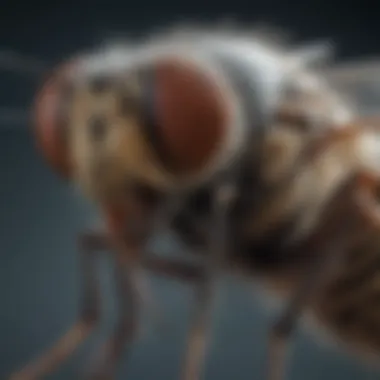

Intro
Large slow-moving flies often blend into the background of our daily lives, yet they play significant roles in our ecosystems. Understanding these insects is crucial for effective pest management and maintaining the balance of nature in our homes and gardens. This article explores the biological characteristics, ecological impacts, and various management strategies related to these flies. By examining their behavior and breeding habits, we gain insight into their interactions with other organisms and human activities.
Understanding Pests
Definition of Pests
Pests are organisms that cause harm to crops, livestock, humans, or property. Large slow-moving flies fit into this category when their presence leads to negative consequences. They can contaminate food, spread diseases, and damage plants. Recognizing them as pests is essential for determining an appropriate response.
Importance of Pest Identification
Identifying pests is fundamental for effective management. Large slow-moving flies come in various species, each exhibiting distinct behaviors and impacts. Mistaken identification can lead to ineffective control measures and wasted resources. Therefore, understanding which species are present allows for tailored management strategies.
"The key to effective pest control lies in the accurate identification of the pest species and their life cycles."
Prevention Techniques
Home and Garden Preventative Measures
Preventing infestations by large slow-moving flies involves several strategic measures. Proper sanitation is the first step. This includes cleaning food spills and properly storing food. Additionally, maintaining a clutter-free environment can limit nesting sites.
- Seal entry points: Close gaps around doors and windows.
- Manage waste: Use tightly closed trash bins.
- Remove standing water: Flies are attracted to moist areas.
Seasonal Prevention Tips
Different seasons present unique challenges regarding fly management. In spring and summer, flies reproduce swiftly. Therefore, increased vigilance is necessary during these periods. Here are some seasonal tips:
- Spring: Inspect outdoor areas for signs of breeding.
- Summer: Set up traps and utilize natural repellents.
- Fall: Prepare for winter by sealing up your home.
Eco-Friendly Pest Control Solutions
Overview of Sustainable Practices
Sustainable practices allow for pest management without damaging the environment. These include integrated pest management (IPM) routines that consider the ecological balance and avoid harsh chemicals. Education is pivotal in implementing such solutions.
Natural Remedies and Their Effectiveness
Several natural remedies can deter large slow-moving flies. Here are some examples:
- Essential oils: Oils like peppermint and eucalyptus act as natural repellents.
- Vinegar traps: Mixing vinegar with soap can trap flies effectively.
- Diatomaceous earth: This natural powder can be sprinkled in areas where flies are prevalent.
Natural remedies are often less harmful to beneficial insects and have a reduced impact on the environment. However, their effectiveness may vary based on the situation.
Prelude to Large Slow Moving Flies
Understanding large slow moving flies is crucial for various reasons. These insects play intricate roles within ecosystems, contributing to processes such as pollination and decomposition. Their interactions with other species and environments are significant for maintaining ecological balance. Despite their importance, many misconceptions cloud their perception. This article aims to clarify their role and provide practical insights for management.
Defining Large Slow Moving Flies
Large slow moving flies can be characterized by their distinctive physical traits and behavior. Generally, they possess a bulky body with slower flight patterns compared to other fly species. These flies belong to several families, including some that are commonly recognized by the general public. They are typically found in habitats rich in organic material, such as gardens and forests. Awareness of these defining features helps in correctly identifying them in various environments.
Importance in the Ecosystem
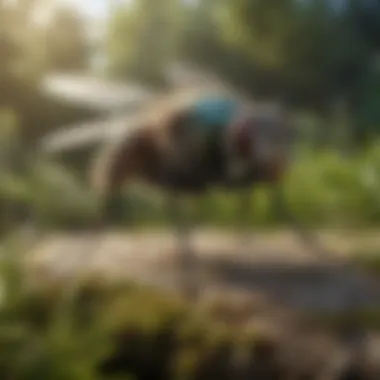
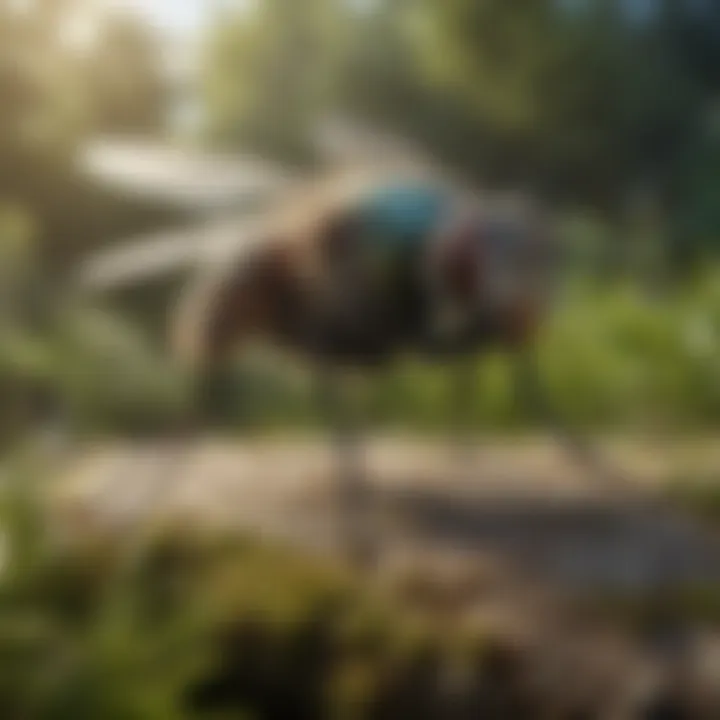
The significance of large slow moving flies in ecosystems cannot be overstated. They serve multiple functions that are beneficial both to nature and humans. Some important aspects include:
- Pollination: Many large flies are effective pollinators, facilitating the reproduction of many flowering plants. Their behavior ensures the survival and distribution of diverse plant species.
- Decomposition: These flies contribute to the breakdown of organic matter, aiding in nutrient cycling. By decomposing plant and animal debris, they enhance soil health.
- Food Source: They act as a food source for various predators, including birds and other insects. This positions them as essential players in the food web.
Ultimately, large slow moving flies represent a vital component of the ecosystem. Their roles support biodiversity and contribute to the stability of natural environments. Recognizing their place in these systems is fundamental for effective pest management strategies.
Types of Large Slow Moving Flies
Understanding the types of large slow moving flies is essential not just for scientific classification but also for practical pest management. These flies vary in their characteristics, habitats, and behaviors. Knowing the different types helps homeowners to identify potential pest issues effectively. It also aids in appreciating the ecological roles these flies play in their environments.
Common Species
Many species of large slow moving flies are recognized in various environments. Some of the most common include:
- Housefly (Musca domestica): This is perhaps the most well-known species. Houseflies often invade homes and are recognized by their dull gray color with four dark stripes on their thorax.
- Fruit Fly (Drosophila melanogaster): Small but significant, fruit flies are attracted to ripening fruits. Their rapid life cycle makes them prominent in homes, especially in kitchens.
- Horsefly (Tabanus spp.): These flies are larger and known for painful bites. They are commonly found near water sources as their larvae develop in wet environments.
- Blowfly (Calliphora spp.): Recognized by their metallic blue or green sheen, blowflies are important in decomposition but can be a nuisance when they invade homes.
- Flesh Fly (Sarcophaga spp.): Similar to blowflies but usually grayer in color. They tend to lay eggs in decaying matter, making their presence unwelcome indoors.
Identification Features
Identifying large slow moving flies is a critical step for proper management. The identification features include:
- Size: These flies are generally larger than regular houseflies. Size varies significantly from species to species. For example, horseflies are notably bigger compared to houseflies.
- Coloration: Many species have distinct colors or patterns. For example, blowflies are known for their shiny metallic bodies, while fruit flies tend to have a more reddish-brown hue.
- Wing Structure: The shape and venation of wings can offer clues about the species. Observing how the wings fold when resting can help determine the species.
- Habitat Preference: Different species prefer various habitats. Observing where a fly is found can assist in identification. For instance, horseflies are often near water bodies, while fruit flies are fond of kitchens.
- Behavior Patterns: Slow moving flies often exhibit certain behavioral traits, such as their tendency to hover around food sources or breeding sites. Noticing these patterns can also guide identification efforts.
Knowing the common species and identification features helps strategize effective management plans. This can reduce infestations and improve home comfort, enhancing the living environment for families.
Biology and Behavior
The biology and behavior of large slow-moving flies is essential for understanding their role in various ecosystems. Recognizing how they develop, feed, and reproduce aids in effective management strategies. These flies are not merely pests; they possess unique life cycles and feeding habits that contribute az significant elements to ecological stability. By learning about their biological characteristics and behaviors, homeowners can engage in more informed pest control and ensure that beneficial aspects of these insects are not overlooked.
Life Cycle Stages
Large slow-moving flies go through several distinct life cycle stages, which include egg, larva, pupa, and adult. Each stage has unique requirements and influences their impact on human environments.
- Egg Stage: The life cycle starts when females lay eggs in areas rich in organic matter, such as decomposing plant material or animal waste. This choice of location supports the larvae, providing necessary nutrients upon hatching.
- Larval Stage: Larvae, often referred to as maggots, emerge from the eggs and primarily feed on decaying organic matter. This stage can last from a few days to several weeks, depending on environmental conditions. During this time, they play a crucial role in decomposition, returning nutrients to the soil.
- Pupal Stage: After adequately feeding, larvae form a protective casing around themselves and enter the pupal stage. This period is vital for transformation, where the fly develops its adult form. This stage commonly lasts for several days until the fully formed fly emerges.
- Adult Stage: Once hatched, adult flies are often characterized by their slow flight and large size. Their lifespan varies, generally lasting a few weeks to a couple of months. Adults are primarily focused on reproduction and feeding, seeking flowers for nectar.
Feeding Habits and Diet
Understanding the feeding habits of large slow-moving flies is crucial for managing their presence, especially when they enter homes or gardens. Unlike many fast-moving fly species, these flies tend to prefer specific types of food sources.
- Decaying Organic Matter: Their larvae thrive on decomposing materials, contributing to nutrient recycling. This is beneficial for the environment, but can be problematic in gardens and homes.
- Nectar and Sugars: Adult flies often feed on nectar found in flowering plants. This feeding behavior may assist in pollination, an important ecological role. However, it can also attract flies toward residential areas, particularly when certain plants bloom.
- Animal Waste: Some species are known to feed on dung, which can lead to disturbances in livestock areas or gardens.
The impact of large slow-moving flies can be both positive and negative, depending on their feeding behavior and interactions with human settings.
Mating and Reproduction
Mating and reproduction in large slow-moving flies is generally tied to environmental conditions and food availability. Understanding these aspects helps manage their population effectively.
- Courtship Behavior: Mating often involves elaborate courtship displays by males. This can include specific flight patterns or pheromone releases to attract females.
- Egg Laying: After mating, the female seeks suitable environments for laying eggs—usually near abundant food sources for the larvae. This ensures that the new generation will have access to ample nutrition right after hatching.
- Influence of Environmental Factors: Weather conditions and the availability of organic matter can significantly influence the timing of reproduction. Warmer temperatures and increased moisture can prompt more frequent reproductive cycles.
In summary, the study of the biology and behavior of large slow-moving flies provides essential insights for understanding their ecological impacts and pest management. By combining knowledge of their life cycles, feeding habits, and reproduction, homeowners can foster a balanced approach to coexist with these flies.
Ecological Roles
The ecological roles of large slow moving flies are multifaceted and essential to the overall health of the ecosystems they inhabit. These flies often serve various functions that can have significant impacts on both the natural world and agricultural practices. Understanding these roles is crucial for appreciating their place in our environment and devising effective management strategies.
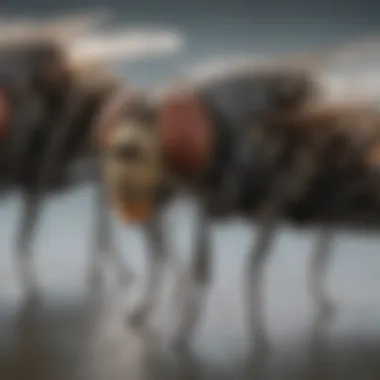
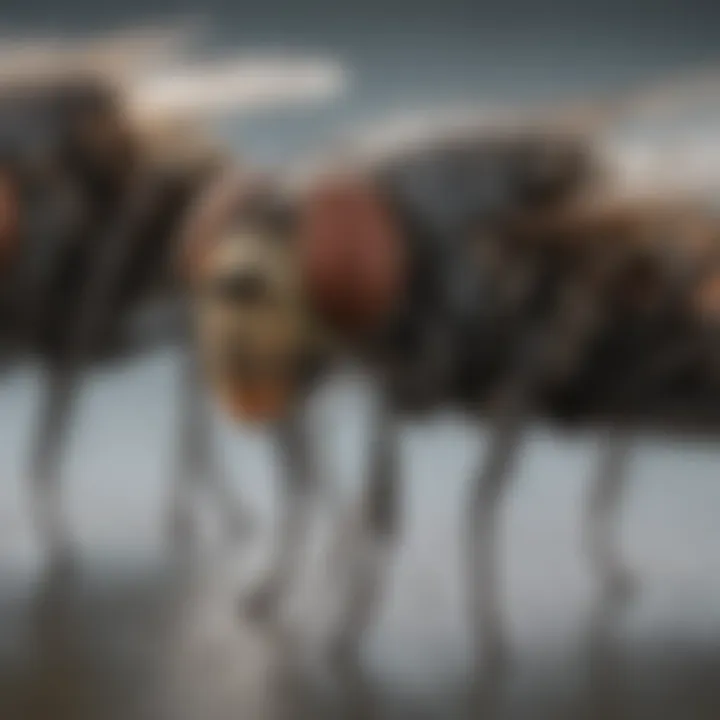
Pollination
Large slow moving flies contribute notably to pollination. Many species, such as the drone fly, are effective at transferring pollen between flowers as they feed. Their body structure is conducive to picking up pollen grains, which they then carry to other plants. This activity is vital for the reproduction of many flowering plants, ensuring genetic diversity and abundance in plant populations.
The reliance on these flies for pollination is often overlooked, yet it has significant implications. In agricultural settings, the presence of these pollinators can lead to higher yields of fruits and vegetables. Encouraging their presence can be achieved by planting native flora that attracts them.
Decomposition Processes
Another critical ecological role of large slow moving flies is in decomposition processes. These flies are often associated with nutrient recycling. They feed on decomposing organic matter, including dead animals and decaying plants. This feeding behavior accelerates the breakdown of such matter. Through their activities, they help return essential nutrients to the soil, enhancing fertility.
Flies like the blowfly play a specific role in this context; they are among the first insects to arrive on a carcass and their larvae contribute directly to decomposition. Thus, they support a clean environment and assist in maintaining ecosystem balance.
Food Source for Other Species
Large slow moving flies also serve as a food source for numerous other species. Birds, bats, and other insects depend on these flies as a vital part of their diet. This interdependence is key to maintaining the food web. Not only do these flies provide essential energy, but their presence also indicates a healthy ecosystem.
While managing pest populations, recognizing the role of these flies as a food source is important. Overly aggressive management could upset natural predator-prey relationships, potentially leading to unintended consequences. Protecting their populations ensures that other species that rely on them remain supported.
"The ecological contributions of large slow moving flies are often underestimated but are crucial for ecosystem health."
In summary, large slow moving flies carry significant ecological roles. Their functions in pollination, decomposition, and serving as a food source for other species highlight their importance. Recognizing and understanding these roles is essential for effective management practices and the ecological balance.
Human Interaction and Impact
Understanding large slow-moving flies is pivotal for households and gardens. These insects do not just exist in their natural ecosystems; their interaction with humans can result in various outcomes that are essential to comprehend. Their roles can be segmented into pest status and economic impact, both of which are critical considerations for effective management strategies.
Pest Status of Large Flies
Large slow-moving flies often encounter negative perceptions. Many cultivation areas and domestic environments find these flies annoying. Their presence can lead to significant challenges, particularly in agricultural settings. They can interfere with crops. In the household, they may invade food sources.
Lifespan and breeding habits contribute to their pest status. Large flies can reproduce quickly, leading to overpopulation in ideal conditions. This contributes to potential disease transmission. Managing their populations is essential in preventing infestations. Homeowners must understand the behavior of these flies to mitigate risks. Simple measures like maintaining cleanliness and proper waste management can deter flies from settling in homes.
Economic Impact
The economic consequences of large slow-moving flies extend beyond immediate annoyance. For farmers, crop damage can result in substantial financial losses. Specific species can affect yields negatively, reducing the quality of produce.
Additionally, industries reliant on agricultural productivity feel the ripple effect. Higher costs may arise when farmers resort to expensive pest control measures or suffer from decreased marketable products. Households are also impacted as the presence of these flies may necessitate increased cleaning efforts, leading to time and resource drainage.
Management Strategies
The management of large slow-moving flies is crucial in maintaining an ecological balance and addressing their interaction with human habitats. Effective management strategies help mitigate negative impacts while enhancing beneficial roles these flies play in the ecosystem. Implementing sound management practices not only targets the flies but also considers environmental health and sustainability. The approach is multifaceted, combining prevention, control, and monitoring strategies that cater to various scenarios faced by homeowners and gardens.
Preventive Measures
Preventive measures are the first line of defense against large slow-moving flies. These strategies aim to minimize the chances of infestation. Some effective preventive actions include:
- Maintaining Clean Environments: Regularly cleaning up food scraps and organic debris in gardens and yards can significantly reduce the attraction for these flies. This effort makes environments less hospitable.
- Proper Waste Management: Use sealed containers for trash and compost. This prevents access to potential breeding sites that may attract flies.
- Use of Barriers: Employ physical barriers such as screens on windows and doors. These barriers can effectively limit their entry into homes.
- Plant Selection: Choose plants that are less attractive to flies or employ companion planting to deter them. Researching which plants repel these insects can be beneficial.
These measures not only prevent infestations but also promote a healthier living space. They require minimal effort for maximum results, making them suitable strategies for house owners and housewives.
Control Techniques
Once preventive measures are in place, it is essential to have effective control techniques ready should an infestation occur. Here are some methods commonly used to control large slow-moving flies:
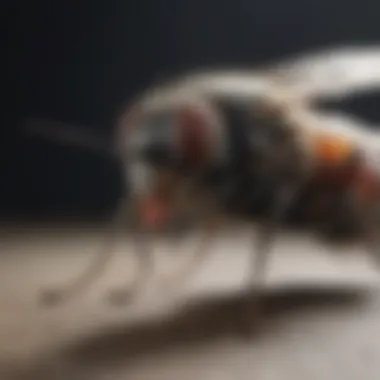
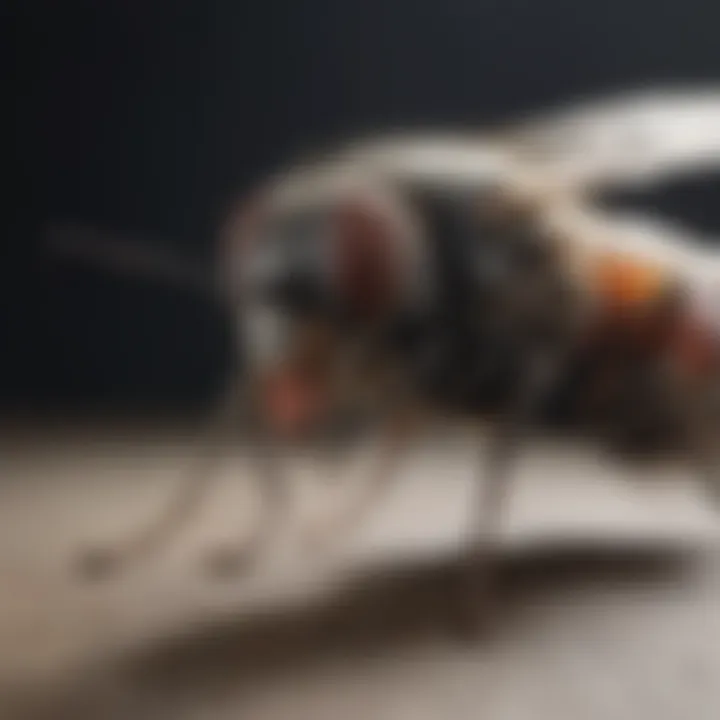
- Traps: Utilize commercially available fly traps or homemade traps with bait. Baits should be chosen based on the specific species that are present, as different flies are attracted to different scents and substances.
- Organic Insecticides: In instances where infestations are severe, organic insecticides may be used. It is important to select products labeled for use against flies to ensure effectiveness without harming beneficial insects.
- Environmental Manipulation: Alter the environment by changing water sources or adjusting light exposure in specific areas. Flies are often attracted to damp conditions, so controlling moisture can deter them.
- Biological Controls: Consider the introduction of natural predators within the environment. Certain birds and insects may keep fly populations in check, allowing for a more balanced ecosystem.
Effective use of control techniques not only aids in managing existing issues but also complements preventive measures. By combining these strategies, house owners can cultivate an environment that is less conducive to infestations.
It is vital to approach management strategies with both consideration for the ecosystem and the desired outcomes in mind. Small changes can yield significant results.
Common Misconceptions
Misconceptions surrounding large slow-moving flies are problematic. These misconceptions can lead to misunderstandings about their biological roles and impact on humans. Therefore, it is crucial to address these thoughts comprehensively.
Debunking Myths
One of the most widespread myths is that large slow-moving flies are purely pests. In reality, their ecological contributions are significant. Many people view all flies as nuisances without recognizing their pollination roles. For instance, species such as the drone fly can aid in pollinating flowers. This should be emphasized
Moreover, some believe that all large flies carry diseases. While it is true that some species can transmit pathogens, many are harmless. They do not have the capacity to spread illnesses, and their presence can play a vital part in maintaining a stable ecosystem. Understanding these specifics is essential for a balanced perspective.
Understanding Their Role
Recognizing the role of large slow-moving flies within the ecosystem is vital. They serve essential functions beyond being perceived as pests. For example, they assist in decomposition by feeding on organic matter. This process helps recycle nutrients back into the soil, promoting growth for plants.
Additionally, it is worth noting that they are a food source for various predators. Birds and other insects depend on these flies to sustain their diets. When we acknowledge their place in the food web, it is easier to appreciate their ecological importance.
Research and Studies
Research on large slow-moving flies is vital for a deeper understanding of their biological characteristics and ecological significance. This section examines the current trends and future directions within entomological study, directly tied to these unique insects. As we explore their roles in ecosystems, management practices, and interactions with humans, findings from recent studies shine light on practical applications and theoretical implications.
Current Research Trends
Recent research highlights various aspects of large slow-moving flies that contribute to our ecological knowledge. Studies focus on their habitats, migration patterns, and interactions with other species. For example, researchers often examine how these flies influence pollination and the stability of food webs. Methods such as ecological modeling and field surveys are standard practices in these inquiries.
Moreover, genetic studies are revealing insights into evolutionary adaptations in these flies. By understanding genetic diversity, scientists gain insights into resilience against environmental changes. These findings can inform conservation efforts and management practices, suggesting that preserving varied habitats can support healthy populations of these insects.
Here are some notable current research trends:
- Behavioral Studies: Investigating mating rituals and feeding habits.
- Ecological Impact: Assessing their role in pollination across different environments.
- Conservation Biology: Focusing on the preservation of natural habitats that support large slow-moving fly populations.
Future Directions in Entomology
Looking ahead, several areas in entomology relating to large slow-moving flies present opportunities for deeper exploration. Future research may delve into the impacts of climate change on their distributions and behaviors. Increased temperatures and shifted weather patterns could change their life cycles and interactions with other species.
Another direction is the integration of technology in ecological studies. Remote sensing and machine learning can help track and predict fly populations and movement. The application of these technologies will enhance our ability to manage and conserve these insects effectively.
In addition to ecological aspects, understanding human impact is becoming increasingly important. Future research may identify the effects of urbanization and agricultural practices on large slow-moving fly populations. This approach can lead to innovative management strategies that minimize negative impacts while enhancing ecological benefits.
Overall, the continued research and exploration of large slow-moving flies promise to enrich our understanding of their complexities and importance in various ecosystems, aiding both scientific inquiry and practical applications for pest management.
Culmination
Understanding large slow-moving flies is vital for a multitude of reasons. These flies play significant roles within various ecosystems, contributing to processes like pollination and decomposition. Their unique characteristics make them both fascinating subjects of study and impactful organisms in their environments.
Summary of Key Points
In this article, we discussed several important aspects of large slow-moving flies:
- Defining Characteristics: We defined what constitutes large slow-moving flies, emphasizing their role in the ecosystem.
- Species Identification: Various species were identified, complete with key features for recognition.
- Biological Insights: We explored their life cycles, feeding habits, and mating behaviors.
- Ecological Impact: Their contributions to pollination, decomposition, and as a food source were underlined.
- Human Interaction: We looked into how these flies can affect human habitats, including pest status and economic impacts.
- Management Strategies: Effective preventive measures and control techniques were outlined.
- Common Misconceptions: Myths were debunked, helping clarify their true ecological roles.
- Research Directions: We highlighted current trends and future research needs in the field of entomology.
Final Thoughts on Management
Effective management of large slow-moving flies is imperative for homeowners and gardeners. Recognizing their beneficial roles alongside their potential for becoming pests is crucial. Implementing integrated pest management strategies can help minimize harm while ensuring that their ecological contributions are not overlooked. Homeowners should cultivate awareness about their behavior and characteristics to better manage interactions. Employing preventive measures and control techniques helps maintain a healthy balance in local ecosystems, benefiting both the flies and surrounding environments.



